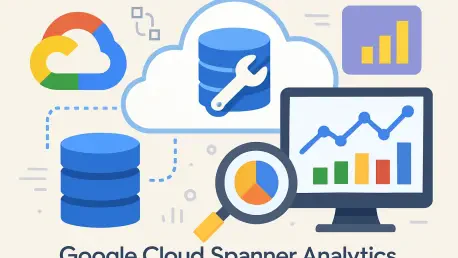In today’s fast-paced digital landscape, where data drives decisions at every turn, Google Cloud Spanner has unveiled a transformative feature that could redefine how enterprises approach real-time analytics. This globally distributed relational database, already a backbone for critical Google services like Ads and Gmail, is renowned for its unparalleled consistency and scalability across vast networks. Now, with the introduction of its columnar engine, Spanner is pushing boundaries further by seamlessly integrating transactional and analytical processing into a single robust system. This innovation promises to deliver lightning-fast query performance on live operational data, effectively closing the gap between online transaction processing (OLTP) and online analytical processing (OLAP). As businesses grapple with ever-growing data demands, this development offers a compelling solution to streamline operations and extract immediate insights without the traditional trade-offs.
Bridging Transactional and Analytical Workloads
Spanner’s columnar engine introduces a groundbreaking approach to data management by unifying OLTP and OLAP workloads, which have long been separated due to their differing performance needs. Historically, transactional systems focus on quick, efficient operations for daily tasks, while analytical systems handle complex queries over massive datasets, often necessitating separate databases or intricate data pipelines. Spanner tackles this divide with a dual storage strategy, maintaining row-based storage for transactional efficiency while automatically converting data into a columnar format optimized for analytics. This behind-the-scenes process ensures that businesses can execute detailed scans, aggregations, and joins on live data without experiencing performance hiccups or disruptive delays, paving the way for a more integrated and responsive data environment.
This unified system also eliminates the reliance on costly extract, transform, load (ETL) processes that duplicate data across platforms, a common burden in traditional setups. By keeping everything within a single framework, Spanner reduces the complexity of managing multiple systems and minimizes latency that often plagues analytics on operational data. The impact of this cannot be overstated for organizations looking to simplify their infrastructure. Developers gain the ability to work with a cohesive platform that supports both immediate transactional needs and deep analytical queries, fostering agility in decision-making. As a result, companies can shift focus from maintaining disparate systems to leveraging data for strategic advantage, marking a significant step forward in database technology.
Delivering Unprecedented Query Speed
One of the most striking benefits of Spanner’s columnar engine is the dramatic improvement in query performance, with Google reporting up to a 40-fold increase in speed for analytical tasks. Where complex queries once took seconds or even minutes to process, they now complete in mere milliseconds, thanks to sophisticated columnar compression and vectorized processing techniques. These advancements optimize how data is stored and accessed, allowing for rapid computation over large datasets. Industry observers and developers alike have expressed astonishment at these results, with many highlighting the potential for such speeds to transform real-time analytics into a practical, everyday tool for businesses of all sizes.
This leap in performance opens up new possibilities for time-sensitive applications that demand instant insights from live data streams. Consider scenarios where every second counts, such as detecting anomalies in financial transactions or adjusting marketing strategies based on current user behavior. Spanner’s ability to deliver near-instantaneous results empowers organizations to act swiftly and decisively. Moreover, the consistency of performance, even under heavy analytical loads, ensures that transactional operations remain unaffected, maintaining the reliability that Spanner is known for. This balance of speed and stability positions the columnar engine as a critical asset for enterprises aiming to stay ahead in a data-driven world.
Slashing Costs and Streamlining Operations
Cost efficiency stands out as another major advantage of Spanner’s columnar engine, addressing a persistent challenge in data management. Google estimates that businesses could reduce infrastructure expenses by as much as 50% by eliminating the need for separate analytics databases and the associated data silos. Traditional architectures often require replicating datasets across multiple systems, incurring significant overhead in storage and maintenance. Spanner’s integrated approach does away with such redundancies, consolidating transactional and analytical workloads into one cost-effective platform that scales seamlessly with demand, offering substantial savings without compromising on capability.
Beyond the financial benefits, this streamlined infrastructure simplifies operational complexity for IT teams tasked with managing data environments. Maintaining fewer systems translates to less time spent on troubleshooting, updates, and synchronization issues, allowing staff to focus on higher-value initiatives like data strategy and innovation. For organizations under pressure to optimize budgets while meeting growing data needs, this reduction in operational burden is a game-changer. Additionally, the columnar engine’s design ensures that cost savings do not come at the expense of performance, providing a balanced solution that aligns with modern business priorities of efficiency and effectiveness.
Transforming Industry Applications
The real-world implications of Spanner’s columnar engine are profound, particularly for industries where immediate data insights can make or break outcomes. In sectors like finance, the ability to analyze live transactional data in real time enables rapid detection of fraudulent activities, potentially saving millions in losses. Similarly, e-commerce platforms can leverage instant analytics to personalize customer experiences on the fly, adjusting recommendations or promotions based on current shopping trends. These applications highlight how Spanner’s technology can drive competitive advantage by turning raw data into actionable intelligence at unprecedented speed.
Integration with existing systems further enhances the engine’s practical value, as it supports standard SQL queries and offers straightforward commands for managing data compaction. This ease of use lowers the learning curve for developers already familiar with relational databases, ensuring that adoption does not require extensive retraining or overhaul of current workflows. For businesses in fast-moving industries, this compatibility means quicker deployment of powerful analytics capabilities, enabling them to respond to market shifts with agility. The potential to transform operational data into strategic insights without delay positions Spanner as a vital tool for industries navigating the complexities of today’s digital economy.
Addressing Early-Stage Hurdles
While the promise of Spanner’s columnar engine is undeniable, it’s important to acknowledge that the technology is still in a preview phase, requiring explicit enrollment for access. This cautious rollout by Google reflects a focus on ensuring stability and reliability before a full production release. Community discussions on platforms like X have flagged potential challenges, including initial bugs or performance inconsistencies in high-traffic environments. Such feedback underscores the need for thorough testing and monitoring as organizations begin to experiment with the engine in real-world scenarios, ensuring that early adopters are prepared for any teething issues.
Despite these hurdles, Google’s deliberate approach to deployment suggests a commitment to refining the technology based on user input and performance metrics. Early adopters have the opportunity to shape the engine’s evolution by identifying areas for improvement, while benefiting from cutting-edge capabilities ahead of wider availability. For businesses considering implementation, attention to schema design and workload optimization will be key to maximizing the engine’s benefits. As the preview phase progresses, the insights gained from these initial deployments are expected to pave the way for a polished, robust solution that meets the diverse needs of global enterprises.
Paving the Way for Future Innovations
Reflecting on the rollout of Spanner’s columnar engine, it’s clear that Google achieved a milestone in database technology by merging OLTP and OLAP workloads with remarkable efficiency. The significant speed improvements and cost reductions delivered during the initial phase addressed critical challenges for data-intensive businesses. Industry enthusiasm, tempered by an awareness of preview-stage limitations, underscored the potential for this technology to redefine analytics standards. Looking ahead, the focus should shift to broader adoption and integration with emerging tools like AI-driven platforms for predictive insights. Organizations are encouraged to explore pilot projects, refine data architectures, and collaborate with Google to iron out early kinks. As case studies emerge, they will likely validate the engine’s impact, guiding others on how to harness this innovation for sustained growth in a data-centric future.









